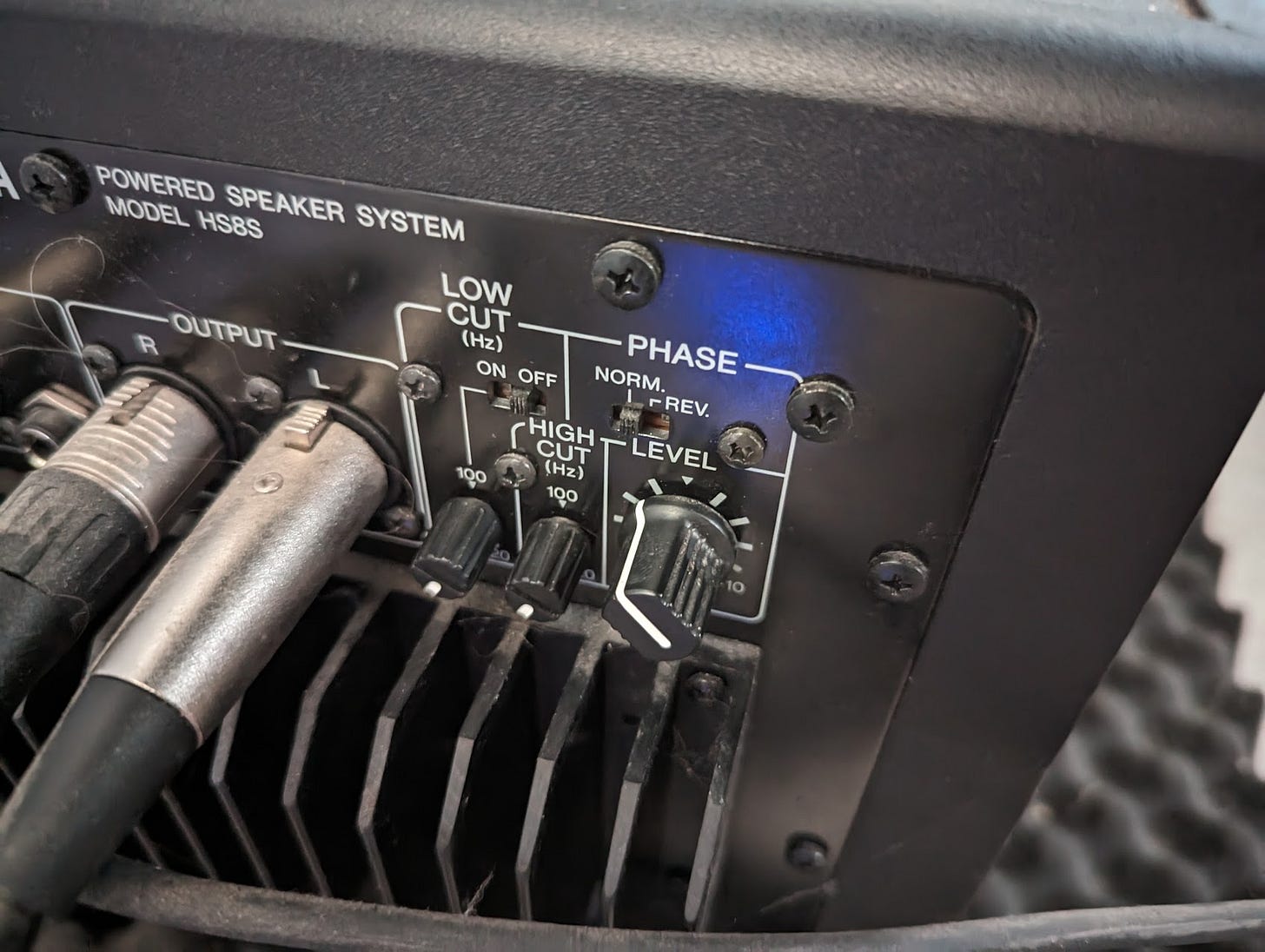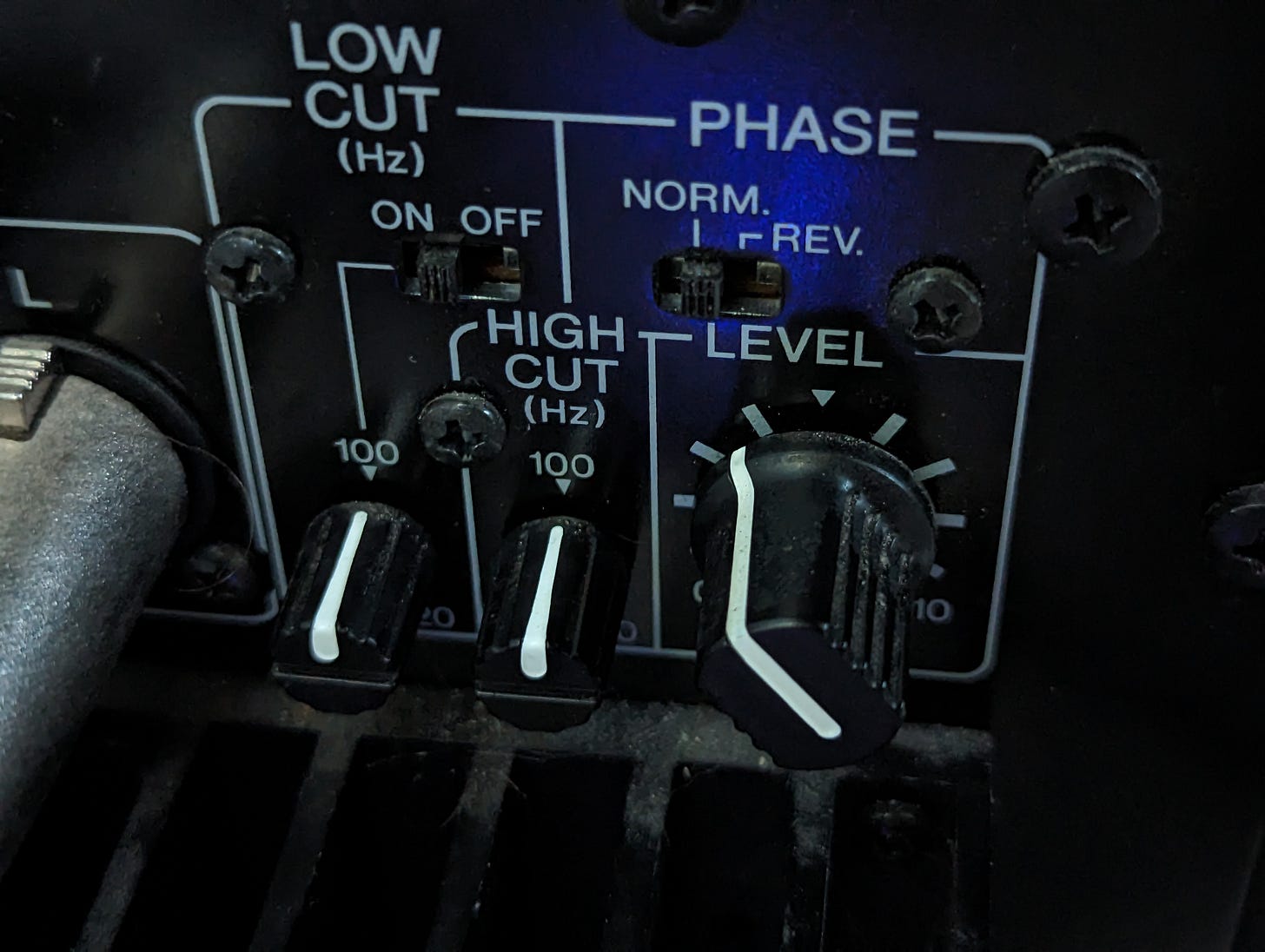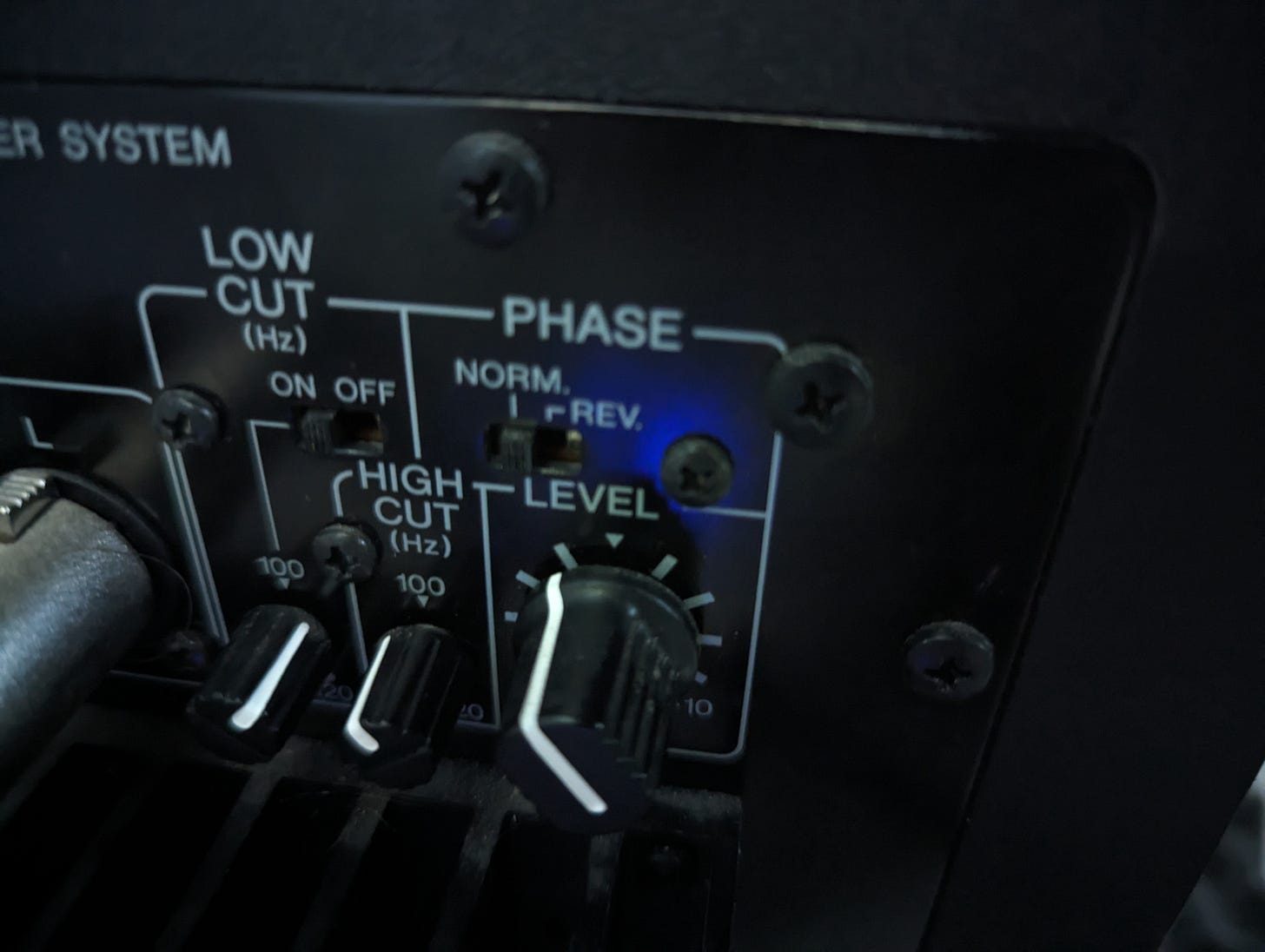How to tune your subwoofer and monitors correctly
The correct way to set the cutoffs on your studio gear.
I've been watching YouTube tutorials on how to set the cutoff correctly on your audio monitors while using a studio subwoofer. If you’ve never gone down this rabbit hole, let me explain.
The settings are sort of a dance between where your monitors, which generally take care of the highs and mids, stop producing the low end sound that they weren't designed for, and where the subwoofer takes over to make those lower sounds.
Anyways, there are thousands of videos on YouTube about this subject.
I was nerding out one day, trying all sorts of different approaches, until I found the holy grail video. It broke everything down in terms of simple physics to me, and suddenly everything became clear. Every once in a while you find a real gem. This video is precisely that. A 2 1/2 minute video just explained something that I apparently haven't grasped completely for at least 10 years.
I watched the video, and then I instantly knew exactly what I have been doing wrong and exactly how to fix it. Other videos mostly tell you loosely how to adjust this and that, where to turn this knob or that. My favorite is when they tell you how it should sound - in the basement dungeon that you dwell in.
I put my newfound knowledge into practice. I started playing a few professionally produced reference tracks, and was now able to hear exactly what I needed to be listening for. My ears have instantly been unlocked into a formerly-unknown area of expertise. I can hear exactly what this guy is talking about.
The whole process took me about 15 minutes and now my studio sounds better than it ever has before, and the best part is, I now understand how to keep it that way.
If anyone else is an audiophile nerd and wants to know what I'm talking about, I can now explain it with pseudo-confidence:
Let’s say you have a subwoofer, and you have a set of monitors to go along. In simple terms, you don't want your subwoofer playing just quite the same frequencies that your monitors are playing, or else they will start to clash and things will sound muddy, like they are being played underwater, sort of. What we want to do is, we want to set the cutoffs on both the subwoofer and the monitors, in order for them to each take care of their own intended job, and not try to do someone else's job.
I've always understood this much. But that's about it. Let's move on...
Both my subwoofer and my monitors have controls that allow me to do this. First things first, let's look up the frequency response of both the sub and the monitors.
I have two Kali LP8 monitors, and a Yamaha HS8S subwoofer. I’m pretty sure I bought this strange combination before the Kali subwoofer was out. I swear. Anyways, the frequency responses are noted at:
Kali LP8: 45hz - 21Khz
Yamaha HS8S - 22Hz - 160Hz
Keep in mind these are probably readings from within the aforementioned ‘anechoic chamber.’ Probably either in Japan for case of the Yamaha, or California for the Kali’s. Your mileage WILL vary. These numbers should give us a good starting point though, and in the end we will be tuning it to our ears and not to some magical numbers that I give you. This isn’t some God particle where you set your sub to this and your monitors to that, and some magic happens, it takes some good old ‘ear tuning.’
OK, so what exactly do we want here? What we don’t want, is overlap. Let’s figure out where our frequencies overlap with the magical factory specs of each device. Remember, we are just talking about low-end here.
Our monitors cut off at the low-end around 45hz. The sub picks up at the high-end around 160hz.
This 45-160hz area in between the two outputs, is overlap. We don’t want this. We want to tone that sub down, so that it picks up right where the monitors leave off. Let’s pick the spot right in the middle of the overlap. Our overlap is from 45hz to 160hz, so the middle-ground would be about 100hz. Let’s aim for that, but as the video explains, if there is a gap, the audio between the cutoffs, below the cutoff db is additive, and fills the gap between the two cutoffs with a perfectly flat signal. Screw it. Let’s try it.
As it turns out, I don’t have a decibel meter. Well hell. What am I going to do?
I’m going to take our newfound knowledge and use my ears to approximate the db level and muck around until it sounds good. That’s what I’ve been doing for 10 years, so let’s try it with a little additional knowledge and see what happens. Why not right? We just learned something on paper that we can translate to knowledge in ear. How cool is that?
I suppose the glaring question here would be: What if you have no gap between where the sub high-cut falls off and where the monitor low-cuts pick up? What if it’s just a flat line? Isn’t that what we want? Does it cause that, now larger, “negative space” to “add up” and make shit sound muddy? Is that ‘additive’ sound now being destructive?
The answer, according to my ears, and my experimentation, is yes. It sounds worse than it does with the ‘gap.’ I will go so far as to say that you do probably want a small gap between cutoffs ledges to allow for that “additive” sound to fill. The actual number to me is questionable, but it seems around a 20Hz gap is a good place to start.
The amount of gap you want, I suppose, is one thing I don’t understand quite fully as of now, but I’m looking into it. I think the size of the gap can sort of bring things a little bit closer or further away perhaps? It’s hard to explain. I tried a lot of different settings, and in the end, for me in my settings, it sounds better to have about a 20Hz gap.
All right enough messing about, lets put it to practice.
On my setup, my audio coming from the audio interface on my computer passes through my sub, which has the cutoff controls for setting both the low-end of the monitors, and the high-end of the sub. It’s almost like perhaps the audio engineers who designed this stuff, have already thought about this, before we even knew what the hell we were looking at! Also - Convenient! We have everything we need in 2 little knobs! Let’s mess about. Here’s what the sub controls look like:
Notice the dust and the hair, and then notice my settings. I’ve got both low cut on the monitors and the high cut on the sub cranked to the left. The knobs are in Hz, and range from 80 to 120. Let’s think about what that might do to our sound, keeping in mind what we just learned. I’ve got both set at 80, and the frequency ranges of both allow for that, but what might happen to the sound as it travels to your ears?
What I’ve gathered is that your speakers are both probably going to struggle at those frequencies.
First, my sub might actually be able to accommodate maybe half of the 20-80Hz reported on the label. I’m talking about the 40-80Hz half. I live in a tight space. That stuff at about 40Hz and below, on a curve, should be cut off in my DAW or whatever input I’m using, on a master EQ. That’s a given, right?
Second, my monitors are probably going to be struggling a little at 80Hz. They advertise a low frequency of 45Hz, but you should give them some room if you have a sub to do so. Don’t make them do that work if they don’t have to. Have you ever had a pair of single-driver headphones in or on your ears, playing some bass-heavy music, and heard the bass kind of drown-out the timbre of the higher sounds? It’s like a weird backwards side-chain compression, where the bass makes the highs duck out while they hit. It sounds gross. Hopefully we don’t have that.
OK back to the knobs. We’re about to fix those. We’re going to find a middle ground between the frequency overlap of our speakers, and then create a gap around that point. Luckily for us, our middle ground here between 45 and 160Hz lies just north of 100Hz. We’re just going to use 100. The knobs are both at 100Hz while at 12 O’clock.
Line ‘em up! Let’s go 100hz for both knobs! That would be a flat line right? Set the sub level (the big knob) to about 3-4 out of 10 for now.
Oh don’t forget to turn on the low cut switch as well (it was off in my picture above.)
So now we’re rocking a 100hz cutoff for both the low-end of the highs and the high end of the lows. Listen to it. Absorb it. It sounds pretty good, no?
Let’s try the gap. They are both lined up at 100hz right now, so lets add a little bit to the low cut of the monitors, and subtract a bit from the high of the sub in order to introduce that small gap:
Now, our cutoffs are kind of pigeon-footed, which is sort of counter-intuitive, thanks to the strange setup of the knobs, but it creates that gap we’re looking for. Our lows are being cut at about 110hz from the monitors, and are coming back starting at about 90hz - from the sub. Creating a 20hz gap.
Important fine tuning step here: We’re going to listen to our monitors without the sub to make sure we aren’t playing that low bass through them. See that big fucking sub level knob? Drop it all the way off. You should hear a clear, and I mean super clear rendition of the highs and mids of your track, with absolutely no lows. This should happen at a good listening level for you. Something that won’t tire your ears after hours of listening.
With the sub essentially off, finely adjust the low cut knob on the sub. You are basically adjusting the point where the monitors stop playing any bass notes. You’re gonna have to play a couple different songs. A good rule of thumb would probably be to listen to a couple songs in your favorite genre, and make sure that those bass notes are not coming through those monitors! As much as I love bass, we want a bass-less sound here. We want just the mids and the highs only. Once you feel you’ve got the low cut set move on to the next step.
Now we’re going to do the opposite. We’re going to drop the level of the monitors to zero and listen to the sub to make sure we aren’t playing any high frequencies from it. If we are, well, you’ll hear higher-timbred sounds coming through the sub. It’s not going to sound good in the mix, your sub should only be dealing with low-end. Go to each monitor and turn the level on the back to zero. Then we’re going to play with the high cut knob on the sub. This is the point where the sub stops playing highs. After a bit of fine adjustment, you should only be hearing the subwoofer by itself at this point. Set it to where it sounds best, keeping it around 110Hz.
Remember at the same time that some things that you think of as higher, like snares, vocals, things like that, usually have lower end components to them nowadays. You will probably hear some low end vocals, perhaps snare hits and maybe tiny remnants of hats in the lower spectrum as well. Those are normal. Just set it to where it sounds the best, but keep it around 90Hz.
Now it’s time to reintroduce your monitors. This for me took a bit of trial-and-error. I had to raise the level a bit and then go back and stand in front of them to judge the sound. Rinse repeat…
What the what? Why can I now hear things like I’ve never heard before? That’s because now you are a smidge closer to listening to the music exactly like the engineer who mastered it wanted you to hear it. Also, You are a smidge closer to having the music you produce on your computer sounding professional on any system now. If you have a nicely balanced setup on your computer, and you are using it to produce music, and your music sounds good on your setup, then your music is gonna sound good on other people’s setups.
Remember, they are called monitors for a reason. You don’t want them to sound good, you don’t want that EQ curve that perhaps you love to set on your headphones while you ride the bus. You don’t want any curve. You want them to sound flat. You want them to sound like what other people are gonna hear, so that you can shape that sound.
Hopefully you can focus a bit more on the sound of your tracks now and stop worrying if it’s going to sound good on other systems. Hopefully I gave you a small chunk of peace while you produce music at home or at the studio. Hopefully I’ve helped you. Please let me know if I have.
I’m open to input - and not only read it, but I usually respond as well, so if you have any, and I mean any, criticism it is welcomed here. Please leave me comments and tell me how wrong I am. In the end that’s what I’m here for. To learn.




